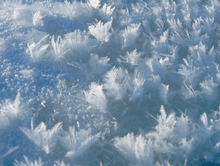Frost flower (sea ice)

Frost flowers are ice crystals commonly found growing on young sea ice and thin lake ice in cold, calm conditions. The ice crystals are similar to hoar frost, and are commonly seen to grow in patches around 3–4 cm in diameter. Frost flowers growing on sea ice have extremely high salinities and concentrations of other sea water chemicals and, because of their high surface area, are efficient releasers of these chemicals into the atmosphere.[1][2][3]
Formation
Frost flowers are formed on thin sea ice when the atmosphere is much colder than the underlying ice. Typically a temperature difference between the ice surface and the air of at least 15 °C is required, though this can be reduced if the air is very humid. In these conditions a layer of supersaturated vapour is found directly above the sea ice, caused by the sublimation of ice into the dry, cold air. As the warmer, wet air meets the overlying cold air it becomes supersaturated and can condense as hoar-frost like crystals on the sea ice surface. In general, frost flowers only form in relatively windless conditions; in high winds the supersaturated layer is scrubbed from the surface and blowing snow obscures the ice surface.[4]
On lake ice, frost flowers are effectively identical to hoar frost crystals. On sea ice, brine is wicked up onto the hoar frost crystals, which leads to high salinities of up to 100 psu (ppt) (approximately three times more salty than sea water).[5]
Frost flowers are most commonly found on young sea ice in polar regions as the large temperature differences between the ice and air are suitable for growth. When the ice grows too thick, the upper surface of the ice cools down and frost flowers no longer grow. This means that frost flowers typically only grow in the first few days of ice coverage.
Morphology
The ice crystals in frost flowers are usually dendritic but similarly to hoar frost can grow in rod-like morphologies. When warm brine is wicked up onto the ice crystals, it can also give the frost flower a 'clumped' appearance as the facets of the ice crystals are partly melted.[6]
Aerosol release
Frost flowers have attracted interest as a possible source of polar atmospheric aerosol. High chemical concentrations and the extended surface area may facilitate efficient release into the atmosphere. In particular studies have shown that abundance of frost flowers can be linked to high concentrations of tropospheric bromine monoxide causing tropospheric ozone depletion events, and higher quantities of airborne sea-salt particles.[7]
Arctic "sea meadows"
On Sept. 2, 2009, a University of Washington biology team sailing back from the North Pole encountered these little flowery things growing on the frozen sea "like a meadow spreading off in all directions. Every available surface was covered with them." When allowed to melt, the one to two milliliters of water recovered was found to hold about a million bacteria. Professor Jody Deming believes that as the poles warm, there will be more and more of these meadows, because there will be more and more open sea that turns to thin ice in winter, and her team is eager to discover what the bacteria living in the frost flowers are doing.[8][9]
See also
References
- ↑ "Mystery of frost flower growth explained - environment". New Scientist. 20 May 2009. Retrieved 2010-03-28.
- ↑ "University of Leeds - Christmassy frost flowers - or symbols of climate change?". Leeds.ac.uk. 2009-12-17. Retrieved 2010-03-28.
- ↑ Roscoe, H. K.; Brooks, B.; Jackson, A. V.; Smith, M. H.; Walker, S. J.; Obbard, R. W.; Wolff, E. W. (2011). "Frost flowers in the laboratory: Growth, characteristics, aerosol, and the underlying sea ice". Journal of Geophysical Research. 116. Bibcode:2011JGRD..11612301R. doi:10.1029/2010JD015144.
- ↑ Style, R. W.; Worster, M. G. (2009). "Frost flower formation on sea ice and lake ice" (PDF). Geophysical Research Letters. 36 (11). Bibcode:2009GeoRL..3611501S. doi:10.1029/2009GL037304..
- ↑ Martin, S.; Drucker, R.; Fort, M. (1995). "A laboratory study of frost flower growth on the surface of young sea ice". Journal of Geophysical Research. 100: 7027. Bibcode:1995JGR...100.7027M. doi:10.1029/94JC03243.
- ↑ Perovich, D. K.; Richter-Menge, J. A. (1994). "Surface characteristics of lead ice" (PDF). Journal of Geophysical Research. 99: 16341. Bibcode:1994JGR....9916341P. doi:10.1029/94JC01194.
- ↑ Kaleschke, L.; Richter, A.; Burrows, J.; Afe, O.; Heygster, G.; Notholt, J.; Rankin, A. M.; Roscoe, H. K.; Hollwedel, J.; Wagner, T.; Jacobi, H.-W. (2004). "Frost flowers on sea ice as a source of sea salt and their influence on tropospheric halogen chemistry" (PDF). Geophysical Research Letters. 31 (16). Bibcode:2004GeoRL..3116114K. doi:10.1029/2004GL020655.
- ↑ Robert Krulwich (December 19, 2012). "Suddenly There's A Meadow In The Ocean With 'Flowers' Everywhere". NPR. Retrieved December 30, 2012.
It was three, maybe four o'clock in the morning when he first saw them. Grad student Jeff Bowman was on the deck of a ship; he and a University of Washington biology team were on their way back from the North Pole.
- ↑ Jeff S. Bowman and Jody W. Deming (January 21, 2012). "Elevated bacterial abundance in laboratory-grown and naturally occurring frost flowers under late winter conditions" (PDF). University of Washington School of Oceanography and Astrobiology Program. Retrieved December 30, 2012.
ABSTRACT Sea ice has been identified as an important microbial habitat, with bacteria and other microbes concentrated in the brine inclusions between ice crystals.... The presence of elevated numbers of bacteria in frost flowers may have implications for the previously observed chemical reactions that take place in them, especially if microbial activity can be shown to occur in this unique low temperature, low water